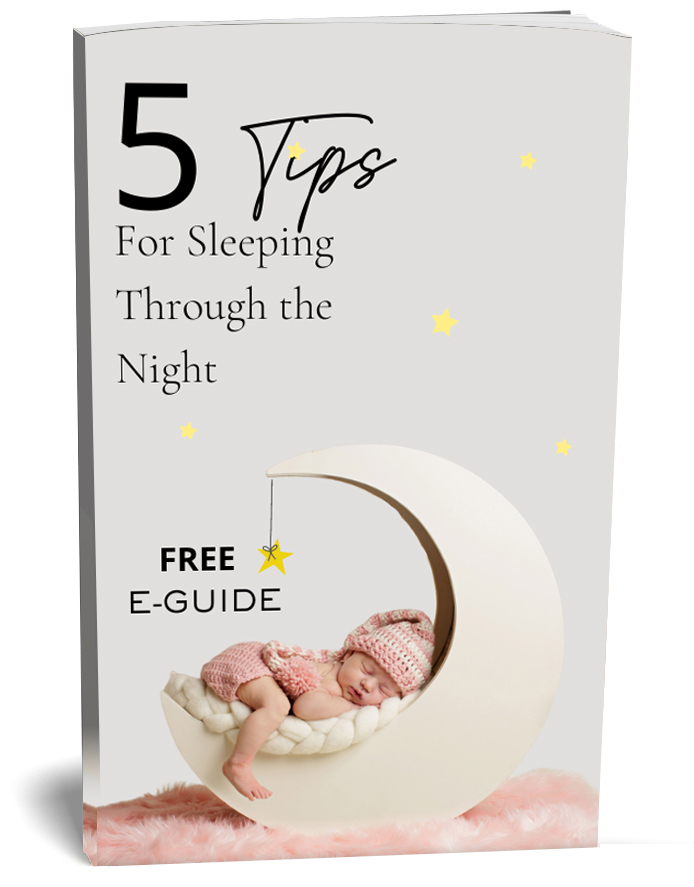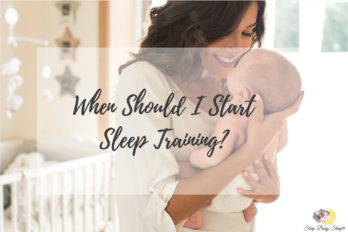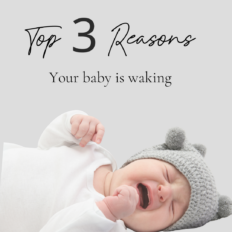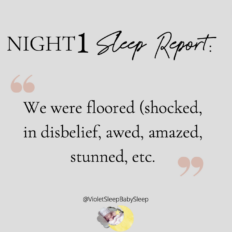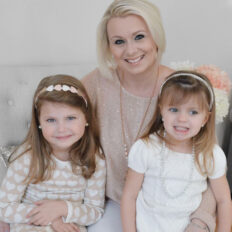

When Should I Start Sleep Training?
Wondering when you should start sleep training your baby? We have all the answers –– plus a step-by step guide on how to gently but effectively teach your baby to get the sleep she needs. Here’s what you need to know.
Start Sleep Training Your Infant Early
Teaching your baby good sleep habits should be started at a very early age, according to experts.
“By three months, sleep habits are fairly set,” reveals Dr. Jodi Mindell, a pediatric sleep specialist.
That means it’s crucial to start your baby sleep training well before this age. (Yes, really.) And yes…it can be done. Once parents know the right way to sleep train their little one, it becomes second nature for the whole family., it happens all the time!)
What is Baby and Toddler Sleep Training?
My definition of “sleep training,” developed over many years and hundreds of happy clients, is this:
Sleep training is the process of helping your baby to get to sleep and stay asleep, by teaching him good sleep habits.
Is Sleep Training the Same as Crying it Out?
Is sleep training basically just the “cry it out” method your great-aunt or a baby book may have told you about?
NO. Please DO NOT confuse the two. Sleep training is a gentle, effective method that teaches your baby to trust herself, trust her environment, and sleep peacefully as a result.
With that said, CIO (cry-it-out) is one sleep training technique, but there are many others.
ONE ONE ONE HELP IS AVAILABLE
VIEW SLEEP TRAINING PACKAGES AND OPTIONS
Should Sleep Training Be Completed All at Once?
No. While you should start your baby’s sleep training early, getting Baby to a place where she easily and consistently falls and stays asleep on her own is a process.
This generally means Baby learning one part of the process, then having the foundation to move forward to the next step.
There are some aspects of baby sleep training that you can achieve early on. Others should wait. (It’s best to have the input of a certified baby sleep consultant or specialist in order to determine exactly when your baby is ready to move on from stage to stage.)
The Stages of Infant Sleep Training
1. Establish a Bedtime Routine
The first part of sleep training is establishing a bedtime routine. You can start from birth, but those first days can be pretty hectic. So we recommend that you establish a reliable, consistent bedtime routine within Baby’s first few weeks.
(Don’t worry –– if you’re late to the game, you can just start from your baby’s current age. Either way, this will be Step One.)
Establishing a bedtime routine is a great start because it helps with day/night confusion, a common problem for new babies who are used to sleeping and waking in the womb without sunlight telling them it’s time to wake.
A Bedtime Routine Reverses Day/Night Confusion
As stated in this important Step: creating a bedtime is key to solving your baby’s day/night confusion. It works because a regular bedtime routine teaches your baby to associate nighttime with sleep.
Create a routine that works for both you and your baby. Things don’t need to be complex at this point; they just need to be consistent. Incorporate activities your baby really enjoys, but that are not too stimulating.
Some ideas are:
- Sing a gentle lullaby (choose the same one each night, or if you sing several, end on the same lullaby)
- Give Baby a light massage
- Read Baby a book
- Give cuddles
Choose elements that help calm your baby. Keep the routine the same every night –– as I’ve said before (and will say again!), consistency is key. When your baby knows exactly what to expect, she feels confident, secure, and will learn to be less anxious about bedtime.
2. Put Baby Down Drowsy, But Awake
I know this is a surprising one to many new parents. It made me do a double-take initially, too.
But it makes so much sense once you think about it (and when you implement it and you and Baby are successful, you’ll be doing your little happy dance!).
Here’s how it works: you put your baby down awake. Yes, awake.
She should not be clapping her hands and looking around eagerly for her next toy, but she should not yet be asleep. In other words, wait for your baby to become drowsy. Then put her into her crib or bassinet.
Why “Drowsy But Awake” Works
I’ll start this explanation by illustrating why putting Baby down only once she’s fast asleep can work against you both.
The way you put your baby to sleep is the way she will expect to wake up in the middle of the night. Like adults do (but most of the time, we don’t remember it later), babies lightly awaken several times a night, and sometimes once at nap time. A secure baby will drift right back off.
But a baby who has fallen asleep cuddling in Mama’s or Daddy’s arms, then wakes up suddenly in pitch-blackness in a crib with nobody around her, can be jarred into full wakefulness, full-on fear, and of course, crying. (Wouldn’t you?)
On the other hand, if you put your baby to bed while he is drowsy but awake, he has fallen asleep in his crib and, though he is slightly drowsy, he will subconsciously or consciously remember that during his several nightly semi-awakenings.
Because he is not waking up in a completely different environment, the experience is not jarring for your baby. He therefore will, after a period of time of repeating this process, fall right back asleep on his own –– without your help.
What About a Newborn Infant?
You can start putting your baby down awake but drowsy as early as the first few days or the first week. However, very new babies are a slightly different circumstance. Your newborn is experiencing everything (literally!) for the first time. If you put your newborn down and she cries hard, she obviously wants and needs to be held.
This is another reason that putting Baby to bed awake but drowsy is the second step. Always do these steps in order for your baby’s confidence and security, and for maximum chance of success.
3. Skip Night Feedings (When Baby is Ready)
In this step, you will help your baby to sleep through the night without any feedings.
That’s the ultimate goal, of course. A very new baby needs night feedings; don’t deny a little one under the age of 8 weeks a meal at night, and always follow the pediatrician’s instructions. (For instance, low birthweight babies or infants with other issues may need frequent feedings for much longer than other infants do.)
IMPORTANT: Ask your pediatrician whether your baby is ready to skip her night feeding before assuming she doesn’t need it yet.
Most pediatricians and sleep experts say a baby will be able to sleep through the night without a feeding anywhere between 3-6 months. At this point, you can start testing your baby to see whether she is truly hungry, or is just using you for comfort.
The Time to Start Sleep Sleep Training is Right Now
Now just because some babies are ready at this age, doesn’t mean they will automatically sleep through the night. Some babies need a little additional help learning good sleep habits and reversing bad ones.
That’s where sleep training comes in. Creating a consistent bedtime, following an age appropriate sleep schedule, teaching your baby to fall asleep on his/her own, and responding appropriately to nighttime wakings are the primary components of sleep training that will help your baby sleep through the night.
Get a Plan, Mama! (I Can Help)
To paraphrase the very perceptive Benjamin Franklin: those who fail to plan, should plan to fail. But luckily, if you’re reading this article, you are the type who wants, and sticks to, a plan. That’s in both your and your baby’s favor.
It all comes down to: if your baby is still waking up multiple times a night (or has other sleep troubles), then sleep training might just be your very best option. (Remember to always check with your pediatrician before starting this or any other infant training to make sure Baby is healthy enough to get started.)
It can be a little confusing figuring out which plan is best. Need a jumping-off point (and a solid plan)? I’m here for one-on-one help, every step of the way. Check out my Baby Sleep Consulting Packages and let’s talk, so you can ensure your baby’s very best success.
What if You Encounter Bumps in the Road?
As life-changing as sleep training is, nothing is perfect when it comes to your little one. She’s an individual, and she may have setbacks along the way. Don’t worry –– that’s normal!
Don’t anticipate setbacks and worry about them, but do be prepared in case they do happen due to an illness, a scare, or even a new milestone that’s keeping your child’s mind and body a little too active at night. Handling these bumps appropriately will be the key to your sleep training success.
Here are some typical reasons at various stages during your child’s first year:
Newborn-2 months
- Day/night confusion. It can take a baby 6-8 weeks to “reset her watch” (as my beloved grandma used to say) and realize that darkness = sleep time. According to the National Sleep Foundation, a baby’s sleep/wake cycle should start to develop at about six weeks and be ingrained by 3-6 months..
- Babies do not start producing enough melatonin, the hormone that helps us sleep, until about 2-3 months. Before this age, some training may be needed in order to help Baby fall and stay asleep through the night (with at least one night feeding for very young babies).
- Your baby will also hit their first 3 growth spurts during this time (1 week, 3 weeks and 6 weeks). Growth spurts can mean interrupted sleep habits, from frequent wakings to longer sleep periods –– often during the day –– which can leave Baby less sleepy at night.
3-4 months
- This is typically when a baby will have his first sleep regression. Remember that he is learning new skills like rolling, turning and kicking and wants to practice –– even at night when he should be sleeping.
- This is also a prime time for Baby’s first growth spurt, which is tied into a disruption of his established sleep habits (see above).
5-7 months
- At this point, most healthy babies will begin to be able to sit by themselves. Babies love to practice sitting, especially when you lay them down to sleep, unfortunately.This will pass once your baby has mastered the skill.
- This is also the time for Baby’s six-month growth spurt.
7-9 months
- Now things really kick (see what I did there?) into gear –– your baby will likely begin crawling during this time.
- This period is usually known as an infant’s second sleep regression. Babies love practicing their emerging skills, like crawling, so it’s going to be hard to get your baby to sleep. Be patient: once your baby figures out the skill she is practicing, she will go back to a normal sleep schedule.
- Babies also begin to understand object permanence at this age. They something exists even when it’s not in sight. So when your baby wakes up at night she may miss you, and may start looking for you.
9-10 months
- Separation anxiety starts to peak. It’s going to at least occasionally be hard for your baby to fall asleep and stay asleep, especially when you come back from a party or event, when your baby was around many unfamiliar faces. Seeing all these strangers eager to scoop up your baby for a hug means your baby may be nervous about separating from you.
- Some babies also begin to stand at this time, usually holding onto something like a table leg (or your leg!). There will be times when you are putting your baby down, and up to a standing position she will go. Your baby wants to practice this skill over and over until it is mastered.
11-12 months
- Time for language development! Babies are thinking of words they have learned, and may be practicing them in their little heads when they should be sleeping.
- This is the time when the 12-month regression can happen. Babies are going through tremendous physical development as they are learning to walk and even climb. This can definitely carry over into sleep.
- At this age, your baby enjoys “testing” you. Now that she is discovering that what she does has a direct effect on your reactions, she may start to refuse naps and bedtime just to see what you will do. Even if you have had a very “easy” baby up until this point, she may now start fighting all sleep times.
Don’t Wait!
Whatever stage your baby is in, you can work around these bumps that come along with the excitement. Your best way is to incorporate a backup plan into your sleep training plan.
But here’s perhaps the most important thing: don’t wait to start implementing sleep training. If you wait, things will get harder over time, because your baby is constantly developing, physically and cognitively. These skills become increasingly complex, meaning it can get harder and harder for Baby to settle down if you haven’t introduced sleep strategies yet.
If you’re ready, but have no idea how and when to start sleep training, I offer personalized sleep plans and support. I will create a step by step sleep plan of how to help your baby to sleep well, based on your baby’s unique situation.
I’m also just an email away. Questions during training? Just ask!
In the meantime, check out my Sleep Consultation Packages, or Sleep Baby Sleep Reviews to see what others are saying about how I have helped their little ones sleep through the night


